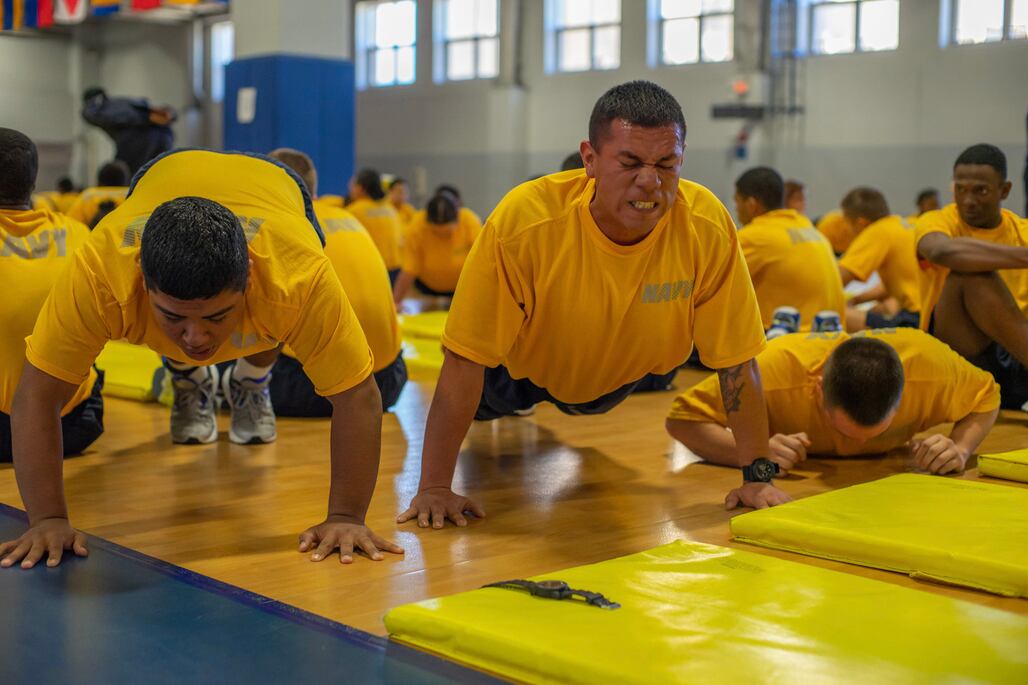The Navy will shake up its physical readiness test by nixing sit-ups and letting sailors use a rowing machine for their cardio scores, the sea service’s top officer announced Thursday.
But don’t expect to see the changes on your next PRT. The reforms are still being developed and the Navy’s goal is have the changes institutionalized by the second fitness test cycle in July 2020.
The Chief of Naval Operations Adm. John Richardson made the announcement in a video posted on his official Facebook page. He was flanked by both Master Chief Petty Officer of the Navy Russ Smith and the crew of the guided-missile destroyer John Paul Jones after a physical training session in Hawaii.
“We’re going to eliminate the sit-ups, because those things have been shown to do more harm than good and not really a good test of your core strength,” Richardson declared.
Instead, Richardson said his service will introduce a “plank event.”
RELATED

Planks are considered better for a sailor’s body because the movements don’t exacerbate lower back injuries, a problem physical fitness experts have identified with sit-ups.
“The plank is a better test of core strength and endurance and will likely reduce lower back injuries or strain due to poor form when doing the curl-up,” said Lt. j.g Stuart Phillips, a spokesman for the chief of naval personnel.
“There is no data that supports curl-ups are the cause of lower back injuries. However, they may aggravate pre-existing conditions.”
An isometric core strength exercise, planks don’t require sailors to flex muscle and joints while performing the movements. Instead, sailors begin the exercise in a position similar to a push-up, except the arms are fully extended and the body’s weight rests on the elbows.
The Navy continues to develop the plank portion of the PRT by charting the “performance norms” that sailors would have to achieve at all ages, Phillips said.
“Training for the plank strengthens the core, improves posture and reduces risk of lower back injuries,” Phillips said.
Training for the event will be simple; costs will be minimal; and it’s logistically feasible to test on board ships, submarines and ashore, he added.
In January, the Marine Corps announced it was investigating a switch from crunches to planks on its physical fitness test, with a decision expected by 2020.
The Navy has been mulling a move to planks since at least 2016, when then-Master Chief Petty Officer of the Navy Mike Stevens considered instituting it as part of a radical shipboard skill-related fitness test.

The sit-up has been a staple of the Navy’s semi-annual PRT for three decades.
Performance is easy to measure — a partner holds a sailor’s legs and counts how many sit-ups are completed in two minutes.
Sailors also perform push-ups and often follow them up with a 1 1/2-mile road run, but the PRT varies by command.
The Navy’s fitness instruction indicates that the road run “remains standard for testing cardio-respiratory fitness” but it allows commanding officers to use “alternate cardio” methods, including jogging on a treadmill, swimming and peddling a stationary bicycle.
Adm. Richardson said the Navy plans to make the rowing machine a fourth “alternate cardio” testing option.
His reform comes two years after the Navy canceled the elliptical option because only 4 percent of those testing opted for that method.
“For all you commands that have rowing machines for your cardio, we’re going to add a rowing machine on to the test as well," Richardson said. "So if you have a rowing machine, you can do that for your cardio.”
Phillips said that test will simulate rowing a boat for two kilometers. The Navy continues to develop tables grading that performance, too.
“Currently the Navy is considering the Concept 2 rowing machine for the PRT,” Phillips said. “The Concept 2 rower does not require validation or calibration, which would reduce the cost to maintain the equipment.”
Phillips lauded rowing machines for their low impact on the body, reducing the “stress on legs,” and how easily they’re stored “on both ships and submarines.”
Richardson said the changes were crafted by feedback from the fleet.
Mark D. Faram is a former reporter for Navy Times. He was a senior writer covering personnel, cultural and historical issues. A nine-year active duty Navy veteran, Faram served from 1978 to 1987 as a Navy Diver and photographer.





